
by Redstage Team | Jun 22, 2016 | eCommerce Platforms, System Integrations
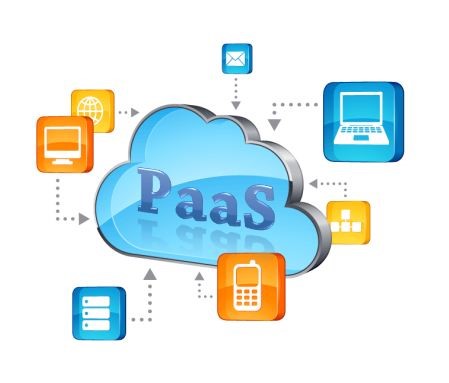
In April of this year, Magento launched its Enterprise Cloud Edition. A Platform-as-a-Service (PaaS) environment designed specifically for Magento 2.0 and runs on Amazon Web Services (AWS). Sounds fancy right? Pretty much! But as an eCommerce merchant I’m sure you’re wondering how you will benefit from this new software and why it’s different from anything you may have currently.
Let’s zoom in a little to look at Magneto’s new baby and its benefits. So what exactly is Magento Enterprise Cloud Edition? Magento themselves describes it as a platform-as-a-service offering that enables rapid deployment of fully customizable, secure, and scalable web storefronts, combined with a leading hosting and managed services infrastructure. Designed to support Magento Enterprise digital commerce software, Magento Enterprise Cloud Edition takes advantage of the architecture and functionality enhancements provided by versions 2.0.5 onward. In simpler terms, the new Cloud Edition enhances Magneto’s Community and Enterprise offerings. Magento enterprise Cloud Edition is hosted; setting up and managing a Magento store is a lot easier for merchants now.
Magento Enterprise Cloud Edition is fully customizable; merchants can now offer customers’ differentiated experiences while they benefit from simplified integration and the ability to respond to changing technology.
The new Cloud Edition also runs on the Amazon Web Services (AWS), to the merchants this means that they will always be ready for high volume in demands for their products, Black Friday and Cyber Monday, will no longer be a nightmare and merchants can spend more time optimizing their stores for customers’. The new platform running on AWS ensures that merchants have the capability to respond to a rapidly changing environment, continuously deploy innovations, and not worry about the day-to-day management of infrastructure.
Breaking barriers as the first of its kind in a post software as a service (SaaS) era. It offers customers the benefits of cloud computing usually associated with SaaS solutions but with a highly performaing and scalable PaaS platform.
![stack[1]](/wp-content/uploads/2016/06/stack1.png)
Magento’s Chief Product Officer, describes the new Cloud Edition as a “game changer.” At the core of Magento Enterprise Cloud Edition are an innovative PaaS that enables merchants and their system integration partners to adopt continuous delivery practices by providing best-in-class DevOps, release management and cloud management tools that make deploying, testing, promoting and operating multiple environments rapid, easy and manageable.
For more information about Magento’s Enterprise Cloud Edition visit their website here.

by Redstage Team | Jun 16, 2016 | eCommerce Platforms, Press
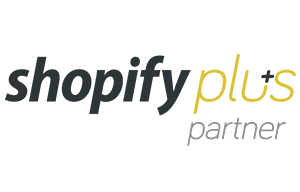 Increases service offerings for clients through the Shopify Plus Partner Program
Increases service offerings for clients through the Shopify Plus Partner Program
Hoboken, NJ – June 15, 2016 – Redstage Worldwide LLC, a boutique agency providing enterprise class eCommerce services to clients, today announced an enhancement to the their service offerings. They will be among the first group of digital marketing and design experts to partner with Shopify Plus for the launch of the Shopify Plus Partner Program; further advancing the future of eCommerce and how businesses succeed.
The new Shopify Plus Partner program will broaden Redstage’s reach in the eCommerce industry and allow them to help thousands of online merchants grow and expand through a partner ecosystem that connects brands with accomplished eCommerce agencies like Redstage. Shopify Plus is a cloud-based, multichannel commerce platform for high growth, high volume merchants. Shopify Plus’ platform benefits for Redstage clients include overall lower infrastructural costs, handling of high order volume, multiple payment options for customers, mobility support, and integration of existing IT platforms.
Expressing his enthusiasm about the launch of the Shopify Plus Partner Program, Redstage CEO Adam Morris said, “We’re very happy to add Shopify Plus to our platform offerings. Shopify Plus gives us a powerful enterprise level toolbox. The platform allows top brands and retailers to reach customers on their preferred shopping channels at an unprecedented speed of implementation.”
“We’re excited to welcome Redstage to the new Shopify Plus Partner Program,” says Loren Padelford, VP and GM, Shopify Plus. “Their experience developing innovative eCommerce properties for their clients was a key factor in having the agency as a launch partner.”
Redstage’s partnership with Shopify Plus will create new opportunities for their clients to benefit from innovative, social and conversational commerce strategies that will improve long term brand awareness. To learn more please visit: https://redstage.com/shopify-plus/or Redstage’s website www.redstage.com. To learn more about the Shopify Plus Partner Program, please visit www.shopify.com/plus/partners.
About Redstage
Redstage is a global leader in eCommerce solutions and consulting for online merchants around the world. Built by marketing experts and backed by a brilliant development team, Redstage has worked with over 600 online stores over the past 8 years. Redstage can design, build, launch and support your store by truly becoming your partner in eCommerce. Redstage is currently supporting the eCommerce needs of companies like SpaceX, Red Dress Boutique, Jura/Capresso, Pixi, Pat LaFrieda and many more.
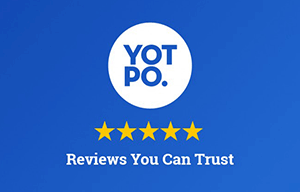
by Redstage Team | Jun 14, 2016 | Commerce Strategy
 This is a guest blog post by Joanna Alter. Joanna Alter is the Co-marketing Manager at Yotpo where she helps businesses maximize the marketing potential of user-generated content.
This is a guest blog post by Joanna Alter. Joanna Alter is the Co-marketing Manager at Yotpo where she helps businesses maximize the marketing potential of user-generated content.
User-generated content impacts conversion rates at every step of the customer journey. It attracts shoppers’ attention, allows them to build a relationship with your brand, and provides authentic and relevant information that helps with purchasing decisions.
UGC refers to any content voluntarily created by your customers and shared publicly. This can include reviews, user-generated photos or customer Q&A. Giving your customers a platform to voice their opinion brings overwhelmingly positive results for your business. Here are three proven ways to increase conversion rates with UGC.
Boost Shopper Confidence
Word of mouth marketing is the best advocacy your store can get. If someone recommends your store to a friend, they are almost certain to check it out. Not only will they visit your site, but they will arrive with their friend’s positive experience fresh in their mind.
Customer content is the online version of word-of-mouth marketing. Displaying customer reviews, photos and questions on your site provides social proof that gives customers the information and confidence boost they need to make a purchase decision.
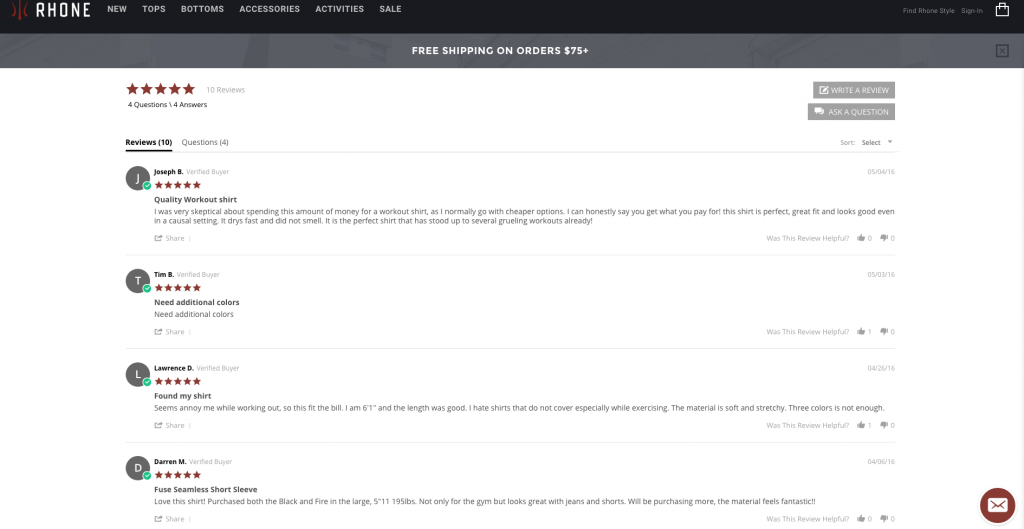
For example, shoppers who arrive at this Rhone product page will see reviews from past buyers that address common pain points specific to buying exercise apparel like itchy seams, shirt length and versatility. Shoppers trust customer content more than they trust branded content. Displaying UGC throughout your site builds trust in your brand and increases sales.
Establish a Relatable Brand Image
User-generated photos are an effective way to reach online audiences that are overwhelmed with content.
Providing immediately visible social proof by including authentic customer reviews and photos on your store and in social media allows you establish a relatable brand image and brings more shoppers to your site. Customer pictures that show people enjoying your product evoke an emotional connection from the viewer. They identify with the experiences and are able to picture themselves enjoying your products as well.
Your biggest fans and most dedicated customers are one of the most valuable marketing resources you have. Getting them to participate in UGC campaigns provides you with repurposable content that you can use across marketing materials and that is relatable for your customers. For example, Boom uses customer photos throughout their website so that shoppers can see how the makeup looks on actual customers. The user-generated photos and reviews provide genuine and relevant information for shoppers that helps them make their purchase decision.

User-generated content elevates an online store’s existing resources, building a community of shoppers and customers who provide social proof for the brand and its products.
Such communities break down barriers between individual online shoppers, which in turn leads to conversions and increased trust in your brand.
Let Your Customer Service Shine
A Yotpo study of 1.3 million customer reviews reveals the importance of good service to online shoppers. Responding to customer reviews and questions highlights your brand’s personality and values, and increases sales and brand loyalty by showing new shoppers and existing customers alike that they are a priority.
All stores receive negative reviews for one reason or another, but this is not entirely a bad thing. Brands should see negative product reviews as an opportunity to show off top-notch customer service, as JerkyXP did in the example below.

Responding to negative reviews is your store’s chance to ensure that customers remember a positive and helpful experience with your brand, as opposed to the initial bad one. Attentive and helpful responses really pay off. 95% of unhappy customers will return to your store if their issue is resolved in a timely and efficient manner.
Key Takeaways
- User-generated content is relatable and valuable to your customers.
- Social proof from customer content like reviews, pictures and Q&A gives shoppers the information and confidence they need to convert into buyers.
- UGC is an effective channel for brands to engage with their customers and build lasting relationships.
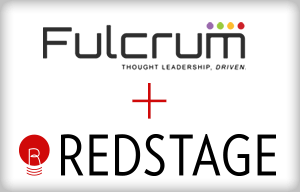
by Redstage Team | Apr 7, 2016 | Uncategorized
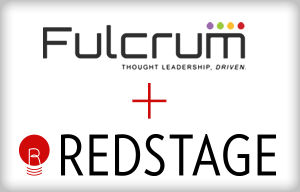 Jersey City, NJ – March 21st, 2016 – Fulcrum Worldwide, a digital transformation and Software-as-a-Service (SaaS) company, announced the acquisition of Redstage Networks LLC, offering eCommerce products to companies across North America. The acquisition will help Redstage, a boutique agency providing Magento – open-source eCommerce platform based services to further boost their growth and performance.
Jersey City, NJ – March 21st, 2016 – Fulcrum Worldwide, a digital transformation and Software-as-a-Service (SaaS) company, announced the acquisition of Redstage Networks LLC, offering eCommerce products to companies across North America. The acquisition will help Redstage, a boutique agency providing Magento – open-source eCommerce platform based services to further boost their growth and performance.
Redstage will continue to operate as an independent business, focusing on delivering robust, scalable eCommerce solutions to help clients build profitable business; with this collaboration it will expand its operations across the UK & Europe by leveraging Fulcrum’s Global Delivery Model and increase the value Fulcrum delivers to its large customer base. This partnership also advances Fulcrum’s footprints in the emerging electronic-retailing segment, realize more return on investment (ROI) for clients and optimize their user experience; over time, Redstage’s solutions will be incorporated into Fulcrum’s service offerings, together delivering next-generation digital enterprise experience.
‘With this association, Fulcrum Worldwide has now one of the most extensive consulting and technology based offerings; we both share deep technical expertise and customer-centric values’ said Rajesh Sinha, founder and CEO, Fulcrum Worldwide. ‘Also, we are excited to add both Adam Morris, CEO, Redstage and Anthony Latona, Chief Marketing Officer, from Redstage to our leadership team; our goal is to expand our portfolio to become an end-to-end services provider for our clients’ he added.
‘Our strategic relationship with Fulcrum will provide key enhancements in our capabilities that will substantially benefit the Company, its employees, and, most importantly, its customers. The partnership opens doors to new markets, rapid project delivery, access to a pool of in-house talented technical resources, and 24/7 support” said Adam. “We look forward to blend Fulcrum’s expertise with our thought leadership and R&D efforts to provide eCommerce market oriented solutions’ he asserted.
About Fulcrum Worldwide
Fulcrum is a CMMi Level 3 appraised digital transformation and Software-as-a-Service (SaaS) company with offices in New Jersey, USA, Reading, UK and software delivery centers in Mumbai and Pune, India. Fulcrum leverages its experience in cutting edge technologies along with its domain expertise in Higher Education, Healthcare, Banking, Financial Services, Insurance and Media to deliver industry-specific solutions. Fulcrum’s offerings include: Enterprise Architecture consulting, Portal and Content Management solutions, Business Intelligence and Data Warehousing implementations, Quality Assurance and Testing Services. Our products: ‘Kaleidoscope’ is a unique combination of a cloud-based platform with higher education-specific features and functionalities, and ‘SupplyDay’ is a comprehensive enterprise solution for the supply chain management needs, automating business tasks and providing real time information. Fulcrum is an IBM Advanced Partner, Microsoft Gold Partner and Liferay Silver Services Partner.
For more information, visit www.fulcrumww.com
About Redstage Networks, LLC
Since 2007 we have created solutions with high sales conversion through elegant technology while promoting brand experience. Our unmatched industry expertise coupled with Magento eCommerce technology produces more sales from your digital channel. Having worked on over 500 Magento businesses, Redstage is the most advanced and experienced agency in the industry. We’re a firm that’s run by accomplished business and marketing professionals and backed by a team of creative and computer science gurus. We’re truly enthusiastic about what we accomplish every day, and we enjoy working with clients that demand excellence and are equally passionate about their business.
For more information, visit www.redstage.com
Contact Information
Dhana Kumarasamy
Fulcrum Worldwide
111 Town Square Place, Suite 1215
Jersey City, NJ 07310

by Redstage Team | Mar 10, 2016 | Commerce Strategy
Unless you have been off the grid for the last year or so, avoiding every type of media in existence (in that case, welcome back to the internet!) you’ve heard the seemingly endless news about the 2016 U.S. presidential race. Now more than ever, there is a constant stream of information including results and statistics, comments from candidates and pundits, and election-related controversy being covered by all channels of the media. While this seems to be spilling over from the realm of politics into that of entertainment, this is the process that has evolved in the age of information. It leads up to people making a choice, whether based on facts, emotion, compromise, prejudice, even misinformation—probably some combination of all of the above for most. There is of course only one President, and it is up to them to convince the voters that they are the one that can best hold the office of POTUS.
In much the same way, shoppers often compare the relative value of a certain product that meets their needs (or wants) at several online shops before deciding what to buy, and where to buy it. Each shop competes for the buyer’s vote, and seldom does one order two or more of the same product from two different stores. While the stakes are admittedly higher in picking the leader of one of the most powerful countries in the world, there are some definite parallels. Shop owners and eCommerce experts can learn a lot from the election process.
The Candidate is the Shop, as Much as the Product
While it may be somewhat satisfying to compare our current crop of candidates to cars, shoes, or brands of detergent on a supermarket shelf, within this examination of eCommerce, the closest analog to the candidate is the storefront. Ultimately your customers will take home or have delivered the product they want, whether they buy it from you or from your competitor. (Getting them to buy a different product is saved for another discussion.) The value proposition, level of trust, presentation, service and yes, the price all contribute to this decision.
The "candidates" for shoppers’ purchase dollars all make themselves known through various channels, from paid search, which is like a campaign ad, to reviews, which can be compared to word of mouth or the press, to social media presence, which is essential in both arenas. In much the same way as a grassroots campaign can be a road to the White House, it is not simply a matter of the most dollars spent on advertising creating the most sales. It requires engagement with your customers.
While watching the debates, both Republican and Democrat, you will see a wide variety of methods by which candidates make their points known. Take for example the platform of better education for American college students. One candidate might cite his or her record on supporting educational bills, devoting funds to improving or building schools, or reducing tuition costs for students. One might propose free education, while another might advocate a more moderate approach of reducing costs and putting limits on debt. When weighing the pros and cons of the policies of your store, you’ll have to consider what’s right for your business when making promises to your customers.
Whatever your value proposition, lay it out in clear, intelligible language and with captivating images. Curate content that highlights not only your product but your brand and the brands you carry. By giving more detail about what sets your shop apart from the competition, you make the case for their vote in your favor.
Run a Clean Campaign or Sling Some Mud?
Another campaign tactic is to attack the competitor’s failings, for example to address a poor record on education in his or her past career as a senator or governor, or to point out the candidate has no experience in this area. Online shops may not usually attack their competitors with such fervor, but each must offer a better proposition. You don’t have to badmouth anyone—it’s probably a bad idea for a number of reasons, one being that you are calling attention to a competitor. This is essentially a passive-aggressive approach. Consider that your customers have already looked at your competitor’s site, or will after they visit yours. What are their failings? Does your competitor who is selling the same product as you, for the same price, offer free shipping? What do their customers say, either in reviews or testimonials, about their record of service? These are all areas where you can prove your worth, and offer value especially if they have failed to do so.
Earn Their Trust
A candidate who says they’re the best without backing up their claims will not appear trustworthy. When he or she gives a blanket promise to solve a problem, but the numbers don’t add up, voters lose confidence. Likewise, online shoppers look at the whole picture. Price isn’t the only decider, as long as it’s competitive. Shoppers are savvy enough to know when something is too good to be true. Instead, detail your policies and provide a warranty of your service. Make yourself available to answer questions and to provide assistance through a toll-free number, chat, and easy to find contact information. Offer a measure of trustworthiness, leveraging your business with specifics such as longevity, e.g. "Selling quality widgets since 1929", or the selection, "The world’s largest selection of widgets," or the quality, "100% handmade, all-natural widgets".
Don’t Repeat the Same Rhetoric Over and Over and …
We’ve seen candidates make the mistake of repeating the same rhetoric, to almost comic effect, or giving repetitive answers to questions when pressed for a more detailed answer. This lack of preparedness makes them look inexperienced, or ignorant of the important topics. In much the same way, shops often cut and paste content such as product or category descriptions from one page or product to another, and often don’t update content on a regular basis. This may cause shoppers to feel that you aren’t paying attention to your store, or at least aren’t bothering to know much about your product. If your home page has the same banners month after month, returning shoppers will notice. Keep the home page fresh with seasonal, sale, or new product banners. Make sure your best-selling products are up to date. If a product has a description from the manufacturer, what can you add so that a customer can really "learn more" on its page? Add your own editorial and personalize the experience. This can be enhanced by offering additional content such as original or buyers’ images, demo videos, or a questions and answers section. If you have a blog or use a social media channel, update it frequently.
Throw Your Hat into the Ring
While issues like Net Neutrality and out-of-state tax laws directly impact stores, most shop owners operate independently of the political process. Nevertheless, shop owners can learn a lot from how campaigns are run and how voters respond to their strategies and actions, successes and failures. By being aware of who is shopping at your store, what they are looking for and how they shop, you can run an online business that will win in 2016—no matter who gets elected next November.


![stack[1]](/wp-content/uploads/2016/06/stack1.png)

 Increases service offerings for clients through the Shopify Plus Partner Program
Increases service offerings for clients through the Shopify Plus Partner Program






 Jersey City, NJ – March 21st, 2016 – Fulcrum Worldwide, a digital transformation and Software-as-a-Service (SaaS) company, announced the acquisition of Redstage Networks LLC, offering eCommerce products to companies across North America. The acquisition will help Redstage, a boutique agency providing Magento – open-source eCommerce platform based services to further boost their growth and performance.
Jersey City, NJ – March 21st, 2016 – Fulcrum Worldwide, a digital transformation and Software-as-a-Service (SaaS) company, announced the acquisition of Redstage Networks LLC, offering eCommerce products to companies across North America. The acquisition will help Redstage, a boutique agency providing Magento – open-source eCommerce platform based services to further boost their growth and performance.
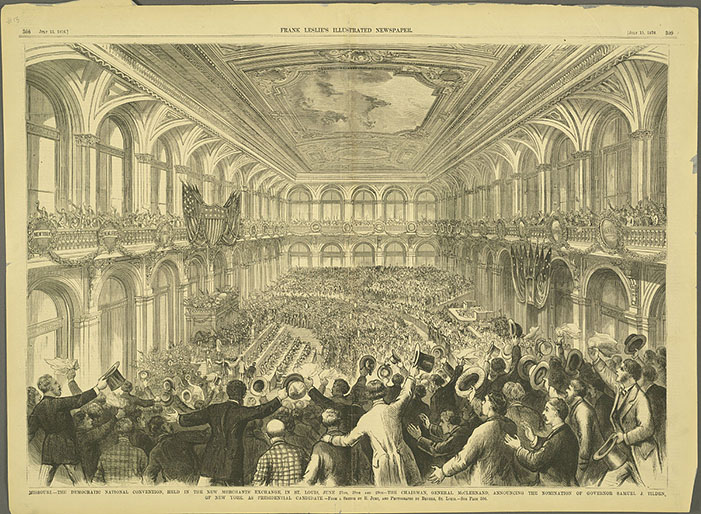
Recent Comments